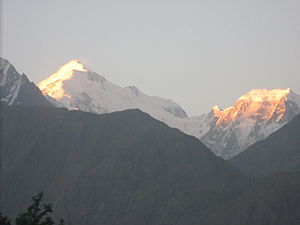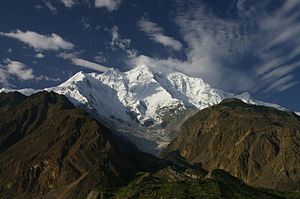Rakaposhi
| Rakaposhi | ||
|---|---|---|
|
Rakaposhi seen from Tagafari Base Camp, on the far right the highest peak |
||
| height | 7788 m | |
| location | Gilgit-Baltistan ( Pakistan ) | |
| Mountains | Rakaposhi Haramosh Mountains ( Karakoram ) | |
| Dominance | 40.9 km → Batura I | |
| Notch height | 2818 m ↓ Haghuch Pass (Naushik La) ( 4970 m ) | |
| Coordinates | 36 ° 8 ′ 33 " N , 74 ° 29 ′ 23" E | |
|
|
||
| First ascent | June 25, 1958 by Mike Banks and Tom Patey | |
| Normal way | glaciated alpine tour | |
|
South side of the Rakaposhi |
||
|
Rakaposhi north face |
||
The Rakaposhi is a 7,788 m high mountain in the Karakoram , whose huge ice walls tower over the Hunza Valley in northern Pakistan . With an altitude difference of almost 6000 m compared to the bottom of the Hunza Valley, the almost 20 km wide north face of the Rakaposhi is the world's highest steep slope.
The Rakaposhi is the highest mountain in the Rakaposhi Haramosh Mountains .
Surname
Rakaposhi means "shiny wall" in the local language. Another name for the mountain is Dumani ("mother of the mist").
Ascent history
The Rakaposhi was first climbed on June 25, 1958 by Mike Banks and Tom Patey . They were members of a British- Pakistani expedition. Previously there were attempts in 1947, 1954 (by Matthias Rebitsch and Anderl Heckmair ) and 1956, but the summit was not reached.
The main climbing routes are:
- from the southeast side over the Goglot-Goh-Glacier ,
- from the northwest,
- from the west over the Pissan glacier .
Ghulmet, a village on the Karakoram Highway , is relatively easy to get to by car. From here the foot of the mountain can be reached in a day's walk. Another option is to climb to the base camp from the small village of Minapin on the northeast side of the mountain.
Web links
- Rakaposhi on Peakbagger.com (English)
Individual evidence
- ^ Himalaya, Pakistan, Rakaposhi . American Alpine Journal, 1959, vol. 11.



